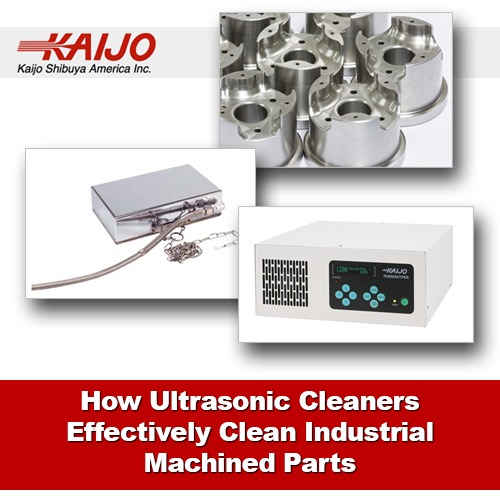How Ultrasonic Cleaners Effectively Clean Industrial Machined Parts
April 16, 2019
 Machined parts come out of production contaminated with a variety of substances. If they have been machined using lubricants, traces of these may remain on the part. The parts may pick up dirt from the shop environment and machining sometimes leaves particles on the machined surfaces. Such contamination is especially harmful if the machined part is used in processes that require high levels of cleanliness. Industrial ultrasonic cleaners provide a cost effective and efficient solution to meet these kinds of cleaning requirements.
Machined parts come out of production contaminated with a variety of substances. If they have been machined using lubricants, traces of these may remain on the part. The parts may pick up dirt from the shop environment and machining sometimes leaves particles on the machined surfaces. Such contamination is especially harmful if the machined part is used in processes that require high levels of cleanliness. Industrial ultrasonic cleaners provide a cost effective and efficient solution to meet these kinds of cleaning requirements.
Machined part specifications for the food, pharmaceutical and medical industries often specify levels of cleanliness that require effective removal of contaminants. Rinsing with solvents may remove the contaminants from parts with simple geometries but rinsing leaves residue as well and doesn’t effectively clean complex geometries such as crevices and dead-end holes. Manual scrubbing is time consuming and may damage the part surfaces. Instead, ultrasonic cleaning can be used with all parts, leaves no residue and does not affect metal surfaces.
Ultrasonic Cleaners Remove Contaminants Quickly and Completely
Ultrasonic cleaners effectively remove oil, grease, dirt and particles from machined parts by producing microscopic cavitation bubbles in the cleaning tank. An ultrasonic generator sends the electric high-frequency signal to ultrasonic cleaning transducers immersed in the cleaning solution. The ultrasonic sound waves create cavitation bubbles in their troughs and the bubbles collapse in the wave peaks. This creation and collapse of the cavitation bubbles results in an intense scrubbing and cleaning action that removes foreign material from the metal surfaces.
The bubbles act wherever there is cleaning solution. As a result, cleaning is effective around complex part geometries inside holes and along ridges or crevices. Cleaning is rapid with a lightly contaminated part cleaned in as little as ten minutes while heavier contamination with tough grease or dirt may take up to twice as long. Ultrasonic cleaning completely removes contaminants down to the bare metal and, depending on the materials and cleanliness requirements, it can take place in pure water. The addition of mild detergents or mild solvents specific to a contaminant may speed up cleaning but is not required.
Selecting the Right Ultrasonic Cleaner Frequency is Critical
The frequency at which industrial ultrasonic cleaners operate affects the size of the cavitation bubbles that the system produces. Low frequencies produce comparatively large bubbles for robust cleaning action while higher frequencies work with small bubbles and deliver gentle cleaning. Typical low frequency ultrasonic cleaners operate at 20 to 40 kHz while high frequencies can range up to the MHz level.
The size of the cavitation bubbles and the corresponding strength of the cleaning action affect how quickly the ultrasonic cleaners can remove dirt and whether the rough cleaning can cause damage to the surface of the parts to be cleaned. Tough deposits and large volumes of solid contaminant often require the action of the low-frequency cleaners. Delicate parts such as semiconductors or medical devices could be damaged by the robust cleaning action of the larger bubbles and need the gentle cleaning of the higher frequencies. Choosing the right ultrasonic cleaner for the application helps ensure that the cleaning performance is as expected.
Low Frequency Ultrasonic Cleaners Work Well for Machined Parts
Most machined parts are made of metal that can easily withstand the robust cleaning action of low-frequency industrial ultrasonic cleaners. Metal surfaces resist pitting and metal structures are solid enough to withstand the cleaning action of the largest bubbles. Occasionally metal alloys or coatings may be relatively soft and comparatively easily damaged. In this case, using an ultrasonic cleaner operating at the lowest frequencies may result in pitting on the part surfaces. Slightly higher frequencies reduce the energy of the cleaning bubbles substantially and can avoid damage to soft parts.
Kaijo has extensive experience in the field of ultrasonic cleaning and its industrial ultrasonic cleaners are designed to meet the cleaning needs of shops producing machined parts. The company can advise customers on the kind of equipment and the frequency needed for their cleaning application and can offer corresponding components and turn-key systems from its complete line of ultrasonic cleaners.





